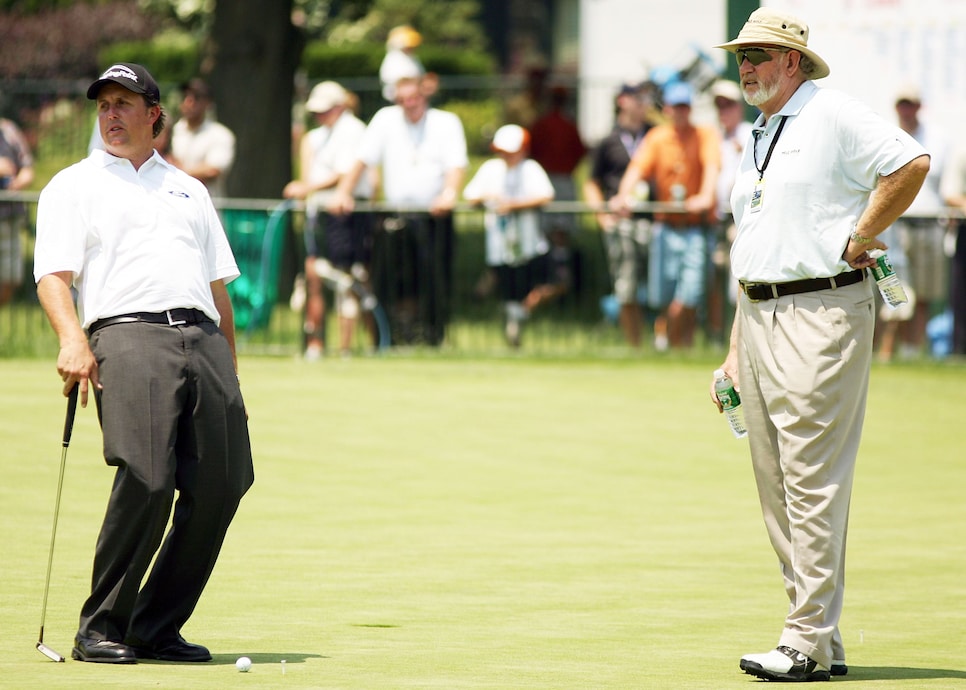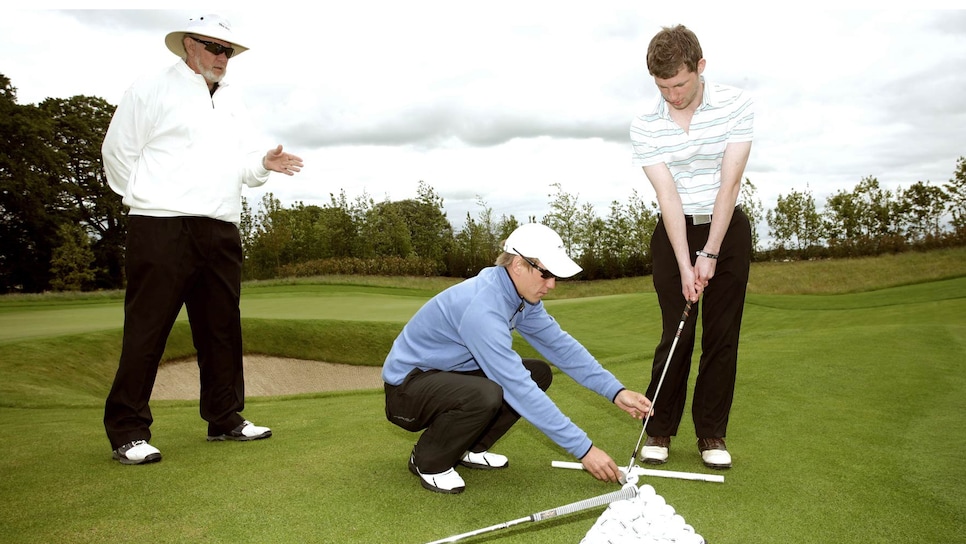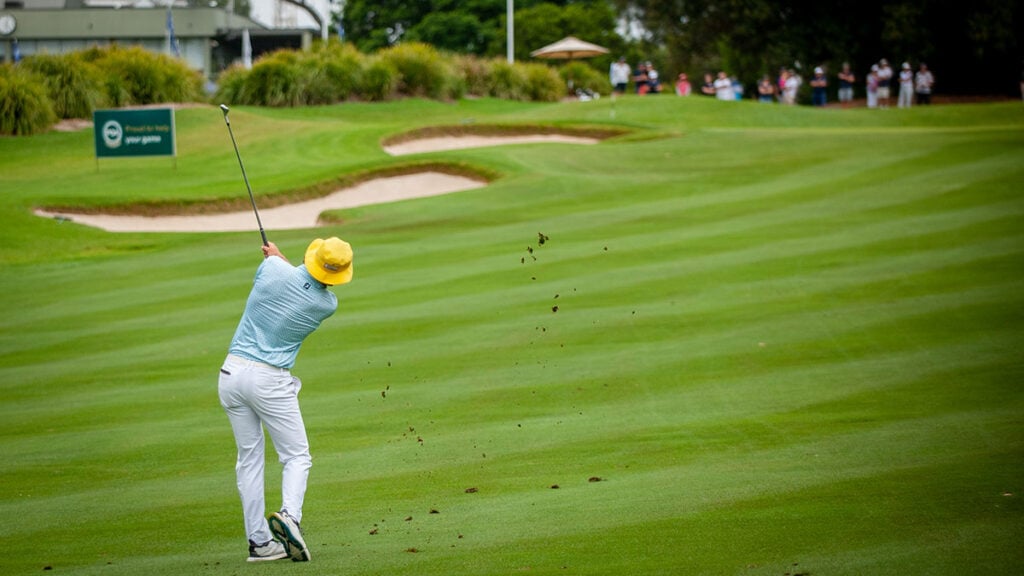Dave Pelz may have been regarded as one of the most important short-game teachers and golf researchers in the history of the game. But in practical terms, his engaging attitude, his comprehensive knowledge and even his distinctive wide-brimmed hat, made him into a kind of golf evangelist, pushing not only the greatest players in the game but millions of average golfers towards a broader commitment to getting good in the short game, the fastest way to improve your score. It’s no wonder one of his most popular books was called simply Dave Pelz’s Short Game Bible.
Pelz died on Sunday at his home in Dripping Springs, Texas. He was 85. No cause of death has been revealed.
Pelz went to Indiana University on a four-year golf scholarship where he studied physics, and while he had hoped for a pro career, he came face-to-face with the fact that he “kept getting beaten by other Big Ten golfers, especially a kid from Ohio State named Nicklaus”. He then spent 14 years as a research scientist at NASA, honing the skills that he would bring to understanding the simple complexities of the short game. It was Pelz’s research that elevated the importance of the short game, with his detailed study showing how 80 percent of the shots lost to par came within 100 yards of the hole.
Pelz impact was vast and diverse. He designed golf clubs and training aids; his Putting Tutor with aiming line and marbles is a tour putting-green staple. His three-ball putter, a solution for aim and alignment problems based on his research, became the inspiration for Odyssey’s legendary 2-Ball putter. He wrote books (Putt Like the Pros and Dave Pelz’s Putting Bible were two other top sellers) and hundreds of articles as a contributor to Golf Magazine for 35 years. He opened a short-game school that taught thousands of players his secrets of the game in and around the greens. He advised tour players from Tom Kite to Phil Mickelson, imbuing them with a sense that they were thinking about the way to greatness in the wrong way.

I have so many things to say about this incredible man. I owe so much of my success to the many things he taught me and he lives on as I share those same insights to numerous other golfers. The laughs we shared along the way is what I cherish most and I look forward to paying… https://t.co/oquBZEwEUQ
— Phil Mickelson (@PhilMickelson) March 26, 2025
Indeed, it was Pelz’s suggestion to Kite that led him to add a fourth wedge, setting him on a pace that resulted in his major triumph at the 1992 US Open. That four-wedge setup, which Pelz came to call his 3X4 System, basically involved envisioning the backswing like a clock and making different length swings with different loft wedges. There isn’t a tour player anywhere not carrying four wedges now, and most average golfers increasingly do the same today. But Pelz was advocating it in the 1980s.
“Dave Pelz was an icon in the world of golf instruction,” said renowned instructor David Leadbetter in a tribute on social media. “His scientific background allowed him to experiment, test and analyse all areas of the game, which through his books, magazine articles, seminars and schools enabled him to pass on his information to the golfing world. Dave was a very modest, kind man who loved the game and had the ear of many of the world’s great players. His work with Tom Kite and its benefits was legendary and one of the many examples of his huge contribution to the game! Phil Mickelson’s career was enhanced greatly because of his association with Dave! He will be sorely missed and he leaves a wonderful legacy that all of us in the golf industry will benefit from for years to come.”
It was Pelz’s inquisitiveness that was contagious and compelling. He saw things that didn’t make sense initially and then got at their root causes. He thought differently about the putting grip, counterbalancing it by choking down on the grip. He analysed relentlessly whether players should hit chip shots with the flagstick in or out. He discovered late in the day the effect of foot traffic around the hole caused otherwise sure makes to miss, the so-called Lumpy Donut effect.
Pelz created his own laboratory at his golf school in Texas, which featured all manner of holes designed to develop short-game skills, including a series of small greens surrounded by sand at specific distance intervals to train distance control. There were even replica holes like the 12th at Augusta National and the 17th at TPC Sawgrass. He made his case by referring to the short game simply as the “Scoring Game”. Through his research he early on made the astute observation that while just about every golfer makes every putt from two feet and how those percentages drop precipitously all the way to 10 feet. His point: develop a way to get shots inside 10 feet and then inside five feet. In a way, his research opened the door for the value of statistically understanding all aspects of the game, the strokes gained analytics that has made professional golfers smarter about what leads to success.
Pelz came to be known by legions of golfers for his 15-year series on Golf Channel, “The Dave Pelz Scoring Game Show.” As Pelz often said on his show, “You can play a lot of good golf if you’ve got a good short game. But remember, practice doesn’t make perfect. Practice makes permanent.”

His mission was a distinctive mix of science and coaching, and he had a genial way of showing his students a smarter approach to enjoy the game more. It was a process focused on improving in the area of the game that was the easiest to practise. As he wrote in his Short Game Bible:
“Don’t be intimidated or discouraged by the number of different shots and areas of practice that are comprised by the scoring game. At every skill level, the putting and short-game skills are the easier to learn and groove than the skills of the power game… None of the concepts or motions in the short game are difficult if you take the time to understand them and then properly practise them. It’s all a matter of knowing what to do, how to do it, then doing it enough.
“…If you are in reasonably good health, if you can walk the meadows and see the clouds, smell the grass and hear the birds, if you can feel the breezes and make contact with the little white ball, you can learn to score better.”




